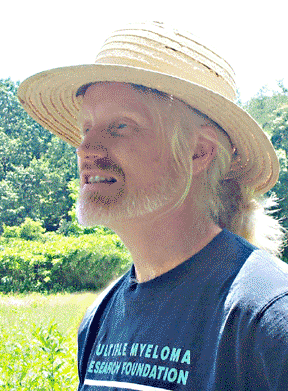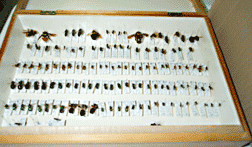 |
|||||||||||
|
|||||||||||
|
|||||||||||
The Local Buzz
On the job with native bee expert Sam Droegeby Carrie MadrenA small white, plastic cup sloshing with diluted dish soap lured and drowned a dozen bees. As the high noon sun beat down, native bee monitor Sam Droege, in a brimmed straw hat, swirls the cup and its lifeless contents. More lasioglossums, he notes, among other bee species, a few bee parasites and a small wasp. Fifteen feet away, he stoops to pick up a similar cup painted light blue inside. Droege’s bees aren’t the European honey-makers whose hives have come under attack by mites so small that they attach themselves to honeybees’ trachea. His bees are native to Maryland and North America, pollinating long before Europeans imported colonizing honeybees. Native bees range from annoying sweatbees to furry bumblebees to iridescent bees to bees that look to us like flying ants or tiny flies. We know so little about these pollinators, Droege says, that we don’t even know who lives in our backyard. Droege, a wildlife biologist for the U.S. Geological Survey, estimates some 350 varieties of native bees call Maryland home. Other estimates place 4,000 native species in North America. Their number may be declining, but nobody knows, and few care. Down to Bees-nessA tall blue-eyed tranquil man with a reddish-whitish ponytail and short beard, habitually clad in jeans and T-shirt, Droege has an affable smile and sharp eye for anything moving near plants. He’s studied native bees at Patuxent Wildlife Research Center for eight years, where he learned that bees do most of the work of pollination. Pollination is Droege’s specialty. Beginning with butterflies, he moved onto bats — pollinators mostly in the Southwestern desert — then moths and flies. Droege, 48, discovered three native bee species, all in urban areas. Hylaeus punctatushe, found in urban gardens near the Smithsonian in Washington, D.C. In downtown Philadelphia, he came across the first East Coast species of Halictus tectus behind the Museum of Art in a median strip between busy lanes of traffic. “I jumped up, making a big spectacle,” he said. He’s collected some 70,000 bees and counting. “Some people go to the Amazon to study birds. I go to Jug Bay Wetlands Sanctuary,” Droege says. “I don’t have to go far to discover bees, and everything is new.”
Zooming In“Few bees can be identified by sight,” says Droege, who must examine most of his subjects under microscopes to identify them. On a sunny summer day, Jug Bay is full of bees: fly-like bees, bumblebees and shiny green bees on flowering plants. Collecting cups — bought in different colors at a party store — lure bees with flower-mimicking colors. Dawn dish soap traps the bees. “This is kitchen science stuff,” he says Back at the Jug Bay lab, Droege rinses bees with alcohol, then washes and dries them in a Mason jar with a screen for a lid. A standard hairdryer dries out the bees for further examinations under a microscope or magnifying glass. Preserved bees are then carefully pinned and labeled. Droege works with a quick, precise hand. He often pins dozens of bees a day — once some 700 — at his Patuxent job. If you try it yourself, on www.discoverlife.org you’ll find a 20 Questions survey to help you figure out what species you’re inspecting. “They’re really pretty under a microscope,” Droege says. Unknown Neighbors“Very few people have actually worked on studying bees,” says Droege, who’s a pioneer in systematizing our natural record. The most recent book of native bees was published in the 1950s. There’s also no dependable state list of species he can turn to. Much of the current native bee data “are all in these obscure journals,” he says, “with keys that tend to be very opaque.” Making the process harder, taxonomy names change through the decades. The reason for our bee naiveté may be that bees are hard to get to know. “We value big huggable things more than small animals — pandas over rats,” Droege says. And birds more than bees. Ornithologists know nearly everything about local birds and bird populations. We have state birds, we have lists of birds in each state. Local parks typically have checklists of common birds. Yet bees are our collaborators in living on Earth. “If all the birds died, we’d be OK,” he says. “But if all the bees died, we’d be in trouble.”
A Pollinating PrecedenceHoneybees — the distressed foreign cousins of native bees — account for most agricultural pollination. Half of the honeybee hives in the U.S. are shipped to almond fields for pollination. Others go to large fields of fruits. Yet their decline is unlikely to doom civilization, though agriculture would certainly be hit hard. “From a natural perspective, we don’t need honeybees,” Droege says. Native bees — which are not subject to the same ills as imported honeybees — are required for half our agriculture and native plants. Native bees are built to pollinate some plants that honeybees can’t. For instance, we wouldn’t have blueberries if it weren’t for our natives. The flowers on blueberry plants are designed for buzz pollinators, Droege explains. Bees like bumblebees that vibrate their wings inadvertently jostle the pollen out. Honeybees rob such flowers of nectar without pollinating. Some plants can be pollinated by only one species of native bee. Pumpkins, for example, need the Peponapis bee. Without native bees, we’d have no pumpkins, another native, nor hibiscus. Old Neighbors Bee-long Bees have been omnipresent for some 90 million years. “Everyone’s house is surrounded by many, many, many bees,” Droege reports. You can get to know your pollinating neighbors better by planting a bee garden. Bees like many of the same plants as butterflies, especially white and light-blue flowers. These native pollinators make their nests and homes in the ground, in beetle holes, or in plant pith. Bare dirt will also attract bees, some of which nest in the soil. Others, like the carpenter bee, bore into wood. Native bees also make good neighbors, because unlike their honey-making cousins, they don’t usually sting. What subtle sting they have doesn’t hurt much. Droege, who’s been stung for being cavalier and careless when working with bees, says that most bees just want to get away. The only exception is the more aggressive female bumblebee. If trapped, it will sting with a little more pinch. Male bumblebees don’t sting. You can safely grab a male bumblebee out of the air in your bare hand. But before you try it yourself, get to know your native bees more closely. Males have white faces. |
|||||||||||
|
|||||||||||
|
|
|||||||||||
|
© COPYRIGHT 2007 by New Bay Enterprises, Inc. All rights reserved. |
|||||||||||



